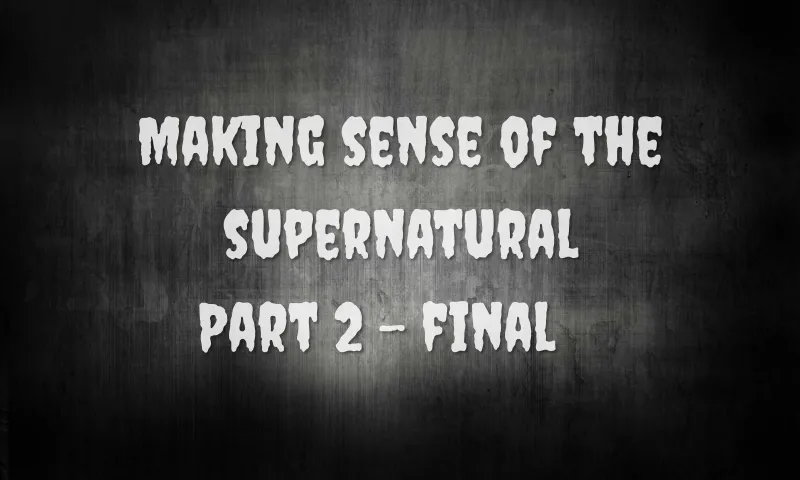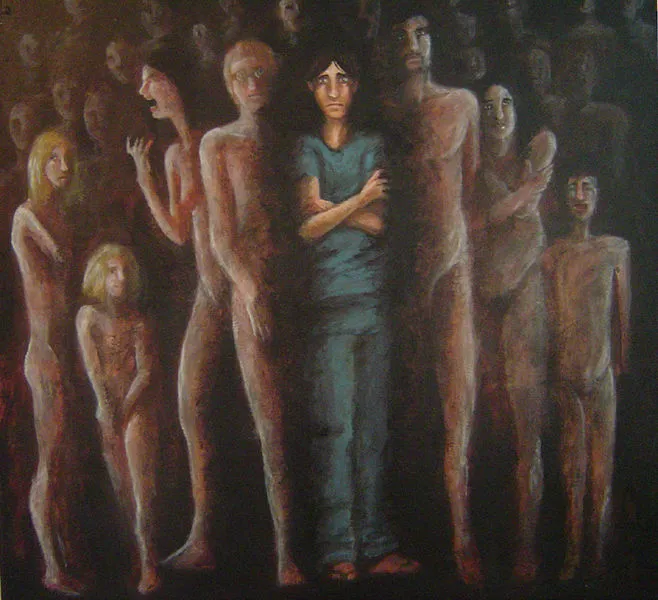
Back in university I had a classmate (Rita) with whom I got together quite often to have lunch. As our friendship narrowed we began to open up to each other; and for a while, the topic we discussed the most was our respectively housemates. Or, should I say bitched 😶? Anyways, it didn’t take long for my complaints (e.g. Oh! My housemate eats my ice-cream!) seem foolish compared to what Rita had to report about the young woman who was living with her back then.
I met Rita’s housemate various times. She was a pleasant, sweet looking young woman, who did a lot of charity work, only watched children’s TV programs, cooked a mean risotto and had an excessive preoccupation with the devil. She and I didn’t talk about anything other than recipes. But, even when the topic was, let’s say, sponge cakes, it would, somehow, turn to the facets of the fallen angel. So, this is the sort of things Rita would concernedly complain to me about her housemate:
“Last night she [Rita’s house-mate] was sobbing on the sofa when I came back home. She was upset that I left her alone. She told me that when she left the kitchen the fallen angel was standing in the corridor blocking the way to her bedroom. She said he looked as if he had his skin inside out.”
In my previous post we discussed how neuropsychology and psychiatry make sense of visual and auditory grieving-hallucinations (through certain types of feelings). But, there are other emotions that prompt the phenomenon too; namely, terror and guilt. This is something that is often portrayed in literature. For example, in the Book Beloved, the character Sethe is haunted by her daughter’ ghost, who she preferred to see dead than living under slavery, and that was the reason why she killed her. Only to, subsequently, be consumed by guilt. You see, Rita’s housemate often made remarks about her terror of being taken away by demons, and also on feeling guilty for repeatedly transgressing the law of God.
The Voice of Satan (Spoiler: Not Really!)

I expect you agree with me when I say that our fears are extremely influenced by our cultural values, environment and upbringing. In his book The God Delusion, for instance, Dawkins talks about a situation a friend of his went through. Someone Dawkins described as an intelligent, mature and very religious man; who once, late into the night during a camping trip, was woken by the terrifying voice of Satan himself! That was an episode which later on in life weighed heavily in his friend’s decision towards becoming a church minister.
Dawkins says that he was so taken aback by his friend’s frightening experience that he would often retell that story. In one occasion, when talking about it with some colleagues that happened to be experienced ornithologists; the group of bird experts shouted in unison “The Devil Bird”. It turns out that the scary cackles and shrieks emitted by that type of bird earned them the not so flattering nickname. But of course, a bird would be the last thing to cross Dawkin’s friend’s thoughts, as his fears and anxieties were rooted in different grounds.
Considering you are willing to embrace the explanation posited by psychology to make sense of visual and auditory devilish hallucinations; so far so good! But, what does the science of the mind and behaviour have to say about cases of demonic possessions? A phenomenon that also permeate history, literature and movies.
Not many Demons, Many Identities.

Dissociative Identity Disorder (DID) is a truly complex mental illness. And one of the reasons for this is the fact that its symptoms overlap with those of many other mental and brain conditions, like psychosis and schizophrenia. Well, so much so, that the psychiatrist (Eugen Bleuler) who actually coined the name schizophrenia and wrote what came to be a classic book about the condition Dementia Praecox or The Group of Schizophrenias largely describes it through what the DSM nowadays categorises as DID.
For example, in his book Bleuler states the following about schizophrenia.
When specific “persons” speak through the patients, in various cases of automatic speech, each “person” has his own special voice and distinct manner of speech. (p.49)
And this is one of the DSM5’s criteria for the diagnosis of DID.
Two or more distinct identities or personality states are present, each with its own relatively enduring pattern or perceiveing, relating to and thinking about the environment and self.
However, this post is not meant to address such complexities. Consequently, I would like you to please imagine someone presenting the aforementioned symptoms in a French convent, back in the 1500’s.
One such person was Jeanne Fery.
The Exorcism of Jeanne Fery

The identities or personality states referred to in the DSM are also known as alters. Jeanne had 50 of them, 49 out of which were all demons (the remaining one was a child) who, according to her own account controlled different parts of her body; for example, her God cursing mouth and blind eye. Jeanne did not always present blindness, this was only one of the many somatic symptoms she suffered from when a given alter identity overtook her sense of self and agency. Some of the other symptoms she presented were: extreme physical strength, refusal to eat and self-mutilation. All of which are seen in nowadays’s DID patients in the form of suicidality, anorexia, etc...
95% of individuals living with DID suffered repeated physical and or sexual abuse before the age of 5. The other 5% of them also report to have gone through traumas, but of different kinds (e.g witnessing something terrifying) *. Jeanne Ferry wrote an autobiography, where she narrated that her first devil appearance (dissociation) happened when she was 4. That was Garga, he turned up to help her not to suffer from her father’s beatings, who also appeared to have repeatedly abused her sexually. It is now accepted that such dissociations occur as an “avoidance coping strategy”, and in current days they are mostly described as monsters or vampires.
But, of course, this sort of understanding was not around in the 1500’s, and this is why in April 10, 1584, Jeanne was taken to the Archbishop, as ‘evil spirits were possessing her body’. Not only did her alters talk/fight to one another, but they also visualised one another. They had names like Cornau (Horn), Sanguine (Bloody) and so forth. According to her exorcists these devils “would trash” Jeanne’s body, as they witnessed her banging her head against the wall, and mutilating her own body (often her genitals). But then again, this is now interpreted as her re-experiencing being beaten (banging the head) and resisting penetration (genital mutilation). In one of Dr. Sacks publications he explains that some life experiences are so emotionally charged that they compel the brain to repeat them over and over again, due to the indelible impression they make.
An exorcism team was then assembled to expel Jeanne’s demons, and a 21-month treatment unfolded. This prolonged period of time is one of the contributors for the alleviation of Jeanne’s symptoms (which worsened from time to time). The parental position taken by her exorcists and the love and care from other nuns also played a fundamental role in her emotional healing. From them Jeanne also had assistance with leaning day-to-day skills and how to carry herself once again, as well as support to write her own story. After all, in January 12 – 1586, during a fit resulted from severe pain due to her body injuries, she heard Mary Magdalene orienting her to make her experience public.
Exorcising our Own Demons

Rita’s housemate spoke fondly of her mother and father. I am confident to say she wasn’t physically or sexually abused as a child. However, she was psychologically mistreated by her parents and other authority figures. She lived under constant watch and accusations of wrongdoings, which were followed by threats that suggested her being kidnapped by an army of demons. Rita’s housemate never considered exorcising her demons, because she thought of them as external beings. Little did she know that they actually lived within her.
I suppose that this is what most of us think as well. But, the ability to recognise our inner-demons and freeing ourselves from them is an empowering one. By ‘our demons’ I mean our obsessions, ill-feelings, insecurities and fears. Naturally, there will be moments of relapse; but the point is never to give in to them. Rita’s housemate wasn’t equipped with this understanding. Last time we saw her was on the day she left Rita’s house, she felt forced to do so because Rita’s boyfriend began to spend the nights there. This was just too sinful for her. So, she fled, with yet more fear and guilt, which would certainly originate more devilish encounters.
Taking a moment to identify and address our demons allows us to know ourselves better through exploring and discovering our own weaknesses and strengths. This is not an easy business; and sure, there is always that one demon that cannot be completely exorcised. But, the idea here is not to allow it to grow, or even multiply for that matter; the way one achieves this is through looking at it right in the eyes. In doing so, after a while, its frightening and intimidating appearance is no more. Then, we begin to see life through a different lens and start to engage with it in a more meaningful manner. 😊
Reference List:
APA (2013) Diagnostic and Statistical Manual of Mental Disorders, 5th edn.
Bleuler, E. (1950). Dementia praecox or the group of schizophrenias. Oxford, England: International Universities Press.
Dawkins, R. (2006) The God Delusion, London, Penguin
Morisson, T. (1987) Beloved, New York, Knopf.
Sacks, O. (2012) Hallucinations, New York, Knopf.
Van der Hart, O., Lierens, ruth., Goodwin, J. (1996), Jeanny Fery: A Sixteen Century Case of Dissociative Identity Disorder. The Journal of Psychohistory, 24(1): 1-12.
Image Source – [1] – I created with Bannersnack,2,3,4,5


Dear Reader,
I know that I normally finish my posts with a question for you. However, today, I thought that it would be more appropriate to leave you with a saying that is attributed to Mark Twain, which I believe it fits this topic really well and also complements the message I have attempted to convey with my short series ❤
